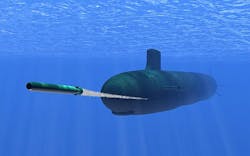Officials of the Naval Undersea Warfare Center Division-Newport in Newport, R.I., announced a $26.4 million contract Friday to Lockheed Martin Sippican Inc. in Marion, Mass., for services to improve the Navy's fleet of CBASS submarine-launched torpedoes.
The CBASS broadband sonar makes the torpedo more effective against emerging submarine classes in the harshest of acoustic environments, Lockheed Martin officials say. The Mark 48 Mod 7 CBASS torpedo uses modern commercial-off-the-shelf (COTS) technologies in an open-architecture computing environment, and can be improved with regular hardware and software upgrades.
This this contract is for engineering to support the future capability upgrades of the Mk 48 Mod 7 CBASS torpedo, as part of the Naval Undersea Warfare Center Division-Newport’s spiral development program.
This includes technology assessment, mechanical and electrical component design analysis, software upgrade development, critical item testing, hardware and software integration, certification and test, in-water validation, and life cycle logistics studies for testing components of torpedoes and subsystems.
Lockheed Martin Sippican experts will recommend design changes; address failure and improvements to weapon hardware, software, and firmware; and support government testing.
The Mark 48 Mod 7 torpedo is standard armament for the Navy's fleet of Los Angeles-, Virginia-, and Seawolf-class fast attack submarines, as well as Ohio-class ballistic-missile and cruise-missile submarines.
The Lockheed Martin Corp. Mission Systems and Training segment in Washington is building the Mark 48 Mod 7 CBASS heavyweight torpedo with advanced common broadband advanced sonar system for expanded operational capabilities for shallow waters along coastlines and inside harbors, as well as in the deep-water open ocean.
Related: Boeing to make flying torpedoes able to attack enemy submarines from 30,000 feet
The CBASS torpedo also has the ability of multiband operation with active and passive homing; advanced counter-countermeasure capabilities; effectiveness against low-Doppler shallow submarines, fast deep diving submarines, and high-performance surface ships; autonomous fire-and-forget operation or wire-guide capability to enable post-launch monitoring and updates via the submarine combat system; and running Otto Fuel II as the propellant.
The Mark 48 Mod 7 CBASS torpedo can transmit and receive over a wide frequency band and use broadband signal processing techniques to improve the torpedo’s search, acquisition, and attack, Lockheed Martin officials say.
The Mark 48 torpedo is 19 feet long, 21 inches in diameter, and weighs 3,500 pounds. It can be used as deep as 1,200 feet at distances as far as five miles. The torpedo can travel at 28 knots and has a 650-pound high-explosive warhead.
On this contract Lockheed Martin will do the work in Marion, Mass.; Newport, R.I.; Pearl Harbor, Hawaii; Australia; Washington; and Keyport, Wash., and should be finished by June 2020. For more information contact Lockheed Martin Sippican online at www.sippican.com, or the Naval Undersea Warfare Center Division-Newport at www.navsea.navy.mil/Home/WarfareCenters/NUWCNewport.



